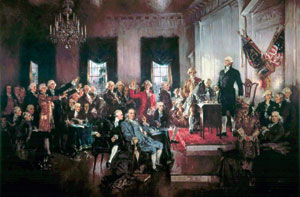CQ WEEKLY – VANTAGE POINT
Sept. 29, 2012 – 12:12 p.m.
A Conventional Approach to Amending the Constitution?
By Shawn Zeller, CQ Staff
The rise of the tea party and the loosening of restrictions on corporate and individual political spending have set the Congressional Research Service to thinking: What would happen if a majority of the states bypassed Congress and demanded a convention to modify the Constitution?

|
||
|
As it turns out, there is no simple answer to the question of how Congress would oversee the process. The Constitution gives states the right to petition Congress — provided that two-thirds (currently 34) do so — to convene a convention to propose amendments to the Constitution; amendments would then have to be ratified by three-fourths of the states.
But many of the specifics of how this would play out are vague, according to a pair of CRS reports by Thomas H. Neale, released this summer. The issue might seem arcane, considering that the states have never successfully called a convention. But there have been attempts. Thirty-three states proposed a convention to consider amendments related to state legislative reapportionment in the 1960s, and 32 asked for a balanced-budget amendment in the 1980s. Another drive, to convene a convention to require the popular election of senators, is credited with pushing Congress to do so on its own with the 17th Amendment in 1912.
In fact, that’s how all of the 27 constitutional amendments have been ratified, through the other process created by the founders: Two-thirds of both chambers of Congress vote to propose an amendment to the states, three-fourths of which must vote to ratify it.
But the CRS contends that the rise of social media has accelerated grass-roots activism — it cites the tea party as an example on the right and the Occupy Wall Street movement on the left — to such a degree that future activists may turn first to the states. It notes the existence of the Friends of the Article V Convention, which has advocated the constitutional convention option since 2007 and has identified more than 700 state-approved calls for a convention, touching on issues ranging from flag desecration to the line-item veto.
Meanwhile, Harvard University last fall hosted a conference on the possibility of a constitutional convention; a range of interest groups participated. And last year, the American Legislative Exchange Council, a coalition of conservative state lawmakers, issued a handbook on how the process would work.
The Friends of the Article V Convention contends that once a state calls for a convention, its request doesn’t expire unless the state votes to rescind the request. But, as the CRS notes, that’s one of many elements that the Founding Fathers left ambiguous. For example, it’s not clear how Congress would convene the convention, how states would be represented at it and whether senators or representatives could serve as delegates. It’s also not certain whether Congress would even have to forward any amendment the convention might agree on to the states for ratification. That issue, the report says, might have to be decided by the Supreme Court.
Some in Congress are thinking about the mechanics of a convention. Last year, Texas GOP Rep.
Neale’s report says one of the biggest unresolved issues is whether a “runaway convention” could propose a far-reaching series of changes to the Bill of Rights, for instance. That, after all, is how the original Constitution was written, in a Philadelphia convention called in 1787 to propose ways to strengthen the Articles of Confederation.